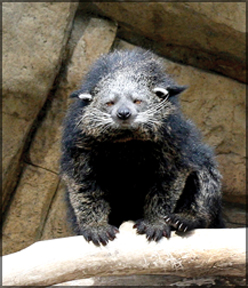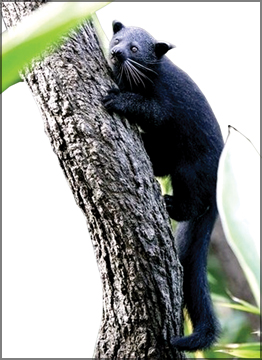|


 Wondering what on earth this creature with such a tongue- twisting
name is? If you think it is either a small bear or a wild cat going by
its looks, you are wrong; itís neither. It is a relative of the fossa
(yet another unusual looking animal we featured recently) and belongs to
the family of Viverridae which includes civets and genets. Wondering what on earth this creature with such a tongue- twisting
name is? If you think it is either a small bear or a wild cat going by
its looks, you are wrong; itís neither. It is a relative of the fossa
(yet another unusual looking animal we featured recently) and belongs to
the family of Viverridae which includes civets and genets.
 The binturong, the only Old World mammal is also known as the Asian
bear cat, Pelawan bear cat or simply bear cat. It is also known as the
Malay civet cat. This creature, which is endearing in appearance due to
its unusual mix of features, is found in Bangladesh, Bhutan, Burma,
China, India, Laos, Nepal, Philippines, Thailand and Vietnam. It lives
in the forest canopy of the rainforests. The binturong, the only Old World mammal is also known as the Asian
bear cat, Pelawan bear cat or simply bear cat. It is also known as the
Malay civet cat. This creature, which is endearing in appearance due to
its unusual mix of features, is found in Bangladesh, Bhutan, Burma,
China, India, Laos, Nepal, Philippines, Thailand and Vietnam. It lives
in the forest canopy of the rainforests.
The reason it is popularly known as a bear cat is its cat-like face
and bear-like body. The binturongís chubby body is covered with long,
shaggy, black fur and the tail which is muscular at the base is
prehensile (gripping). A leathery patch at the tip of the tail helps it
to grip. The binturong is one of two carnivore with a prehensile tail.
The other is an animal called the kinkajou.
The burly binturong has small round ears with long tufts of hair on
them, somewhat like those of koalas. Its eyes too are small and
reddish-brown in colour. The white whiskers on its snout are stiff. The
head to body length of an average adult is 60-96 cm (24-28 inch) while
the tail is almost the length of the body - about 55-90 cm (22-36 inch)
long. The weight is 9-14 kg (20-31 lbs). Females are about 20 per cent
bigger than the males.
This Old World Mammal which belongs to the genus Arctictis may be
omnivorous, but eats fruits primarily. However, its diet include seeds,
shoots, leaves, eggs and small mammals like rodents and birds. It is
known to be the only animal capable of digesting the seed coat of the
Strangler Fig, an important tree in the rainforests.
As it lives mostly on trees in the forest canopy, it is good at
climbing and leaping. It uses its bushy prehensile tail and claws to
cling on to branches when leaping from tree to tree. It has the ability
to rotate backwards the ankles on its hind legs in order to get a better
grip with its claws when coming down trees; head first.
The binturong has a flat-footed walk like a bear or human. When
moving on the ground it ambles(moves along) much like a bear. It is
often confused with sloths due to its slow movements on trees.
  Typically, the female gives birth to one or two offspring after a
gestation (pregnancy) period of 91 days even though it can have up to
six young in one litter. The offspring are born with sealed eyes and
generally stay inside the mumís thick fur during the first few days. The
weight at birth is about five ounces (142 gr). After being nursed for
six to eight weeks, they start to eat solids. These cute bear-like
creatures reach maturity when they are about three years old. Typically, the female gives birth to one or two offspring after a
gestation (pregnancy) period of 91 days even though it can have up to
six young in one litter. The offspring are born with sealed eyes and
generally stay inside the mumís thick fur during the first few days. The
weight at birth is about five ounces (142 gr). After being nursed for
six to eight weeks, they start to eat solids. These cute bear-like
creatures reach maturity when they are about three years old.
Researchers claim that when the animal is content it makes a
chuckling sound, like how cats purr when they are feeling good. A
high-pitched wail is made when it is annoyed. Apart from these sounds,
it also uses grunts, low growls and hissing sounds to communicate with
each other or warn other animals.
The tail too plays a key role in communication. It has been observed
that the binturong brushes its bushy tail which has a scent gland
underneath, against trees and howls to announce its presence to others.
The musk smell from this gland is likened to the smell of warm popcorn
or corn bread.
Even though this creature, like many others, does an important job in
the forest helping in controlling pests and spreading seeds (for
replanting) through its faecal matter, its existence is threatened due
to deforestation and also hunting. Some keep them as pets. In captivity
they live for 20 years or even more.
Today, the binturong too is facing the threat of extinction. It has
been classified as vulnerable in some parts and endangered in others
within its range of habitat.
Will we lose yet another animal friend from our planet soon? No one
knows what this little creatureís fate would be.
|
Quick facts
* The binturong (Arcticitis binturong) is a frugivorous animal,
meaning it feeds mostly on fruits.
* It is a very slow moving, arboreal animal that usually lives alone.
* When resting on a tree it will lie on its stomach with its feet
dangling. However, with its prehensile (gripping) tail it will hold
firmly onto the tree to prevent itself from falling.
* It is a very good swimmer and very playful too. Researchers have
observed it leaping five feet into the air to catch prey.
* The female has its first litter when it is two or three years old
and breeds in March, April, October and November.
* It has a keen sense of smell, good vision and hearing too.
* It is highly endangered in parts of its range and threatened or
vulnerable in others due to habitat destruction.
* The word binturong is said to be of Malaysian origin.
* The binturong is also called binnie for short and has many claims
to fame such as its funny ear tufts which are twice as long as its ears,
huge black and white whiskers that grow up to eight inches long and
almost human looking rear foot soles. |
 |

